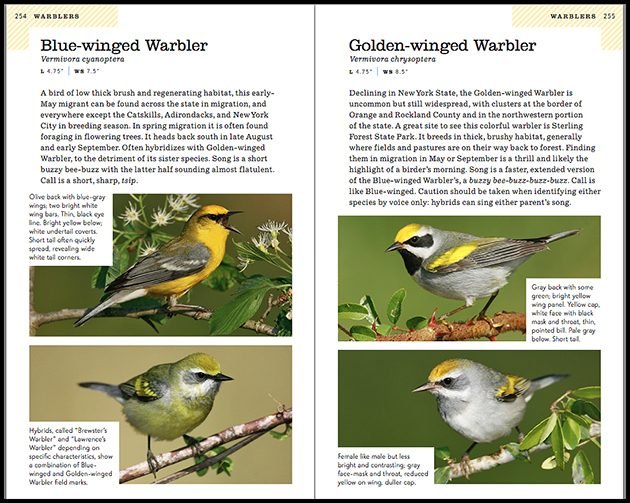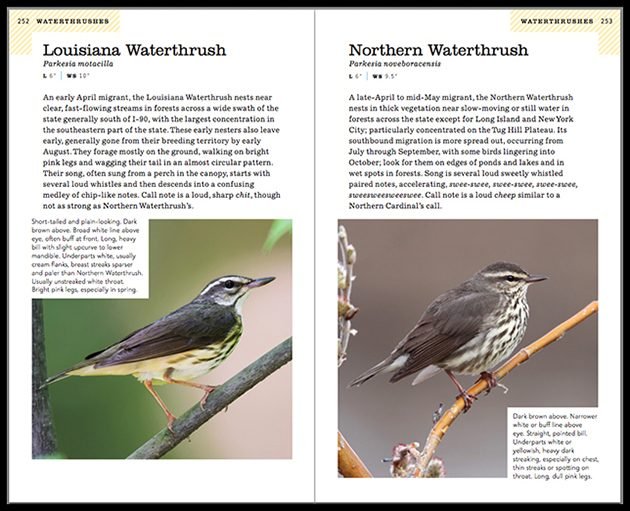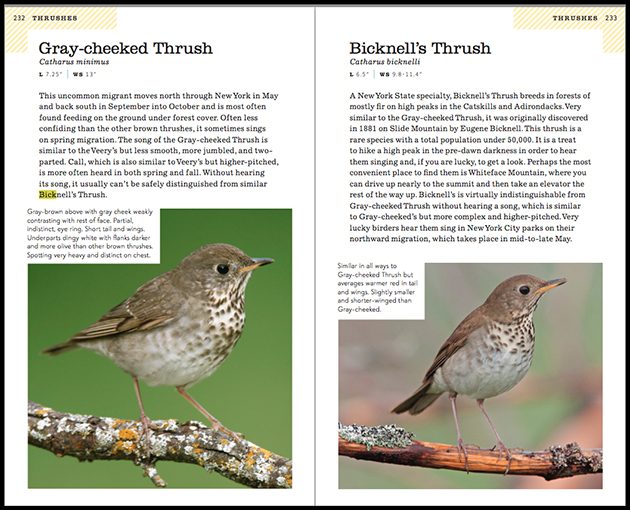
What is the best bird you’ve seen in New York State and why has it stayed in your memory? This is the question I posed to 10,000 Birds readers in celebration of Corey’s first book, the ABA Field Guide to Birds of New York (by Corey Finger, author, and Brian E. Small, photographs, published by Scott & Nix). I thought about what my answer would be and I ended up torn between Golden-winged Warbler and Piping Plover. I seek out Golden-wings in Sterling Forest in late spring, and Piping Plovers on the shores of Long Island in June and July. Both are declining species who have attracted the attention of birders and conservationists, and both are hanging on, showing the remarkable spirit that I think characterizes New Yorkers throughout the state. So, I treasure every sighting.
Here are some of the New York State birds that 10,000 Birds readers think of as memorable, and the great stories about how and when they saw them:
Winston Poon selected Northern Waterthrush, which he saw at Rockefeller State Preserve on May 16, 2016. The extra nice thing about his choice is that he saw it because of a 10,000 Birds post:
In my planning to visit my daughter in Sleepy Hollow NY I checked out birding in the area and came across Corey’s excellent blog from June 2, 2011 about birding Rockefeller State Park Preserve. This was my first time birding NY State and I only had one day for birding so I decided to spend my time there, as it was close to where I would be staying. The Northern Waterthrush was my first of the year, a beautiful bird with it’s tail pumping action.
Nathan O’Reilly’s most memorable bird was one many birders from New York State and beyond drove to see in 2015. Nathan saw it on a particularly exciting day:
Borrowed a friend’s car to go up to Shawangunk Grasslands to look for the reported Gyrfalcon. Had no luck at all that morning but then a report came in that it was seen just north in Gardiner. Drove up to Gardiner and found a spot along a bend in the river on a small road. Within 15 minutes the Gyrfalcon flew in. Not only did it fly in but it attacked a Bald Eagle! The Bald Eagle was flying upside-down with talons up trying to ward off the small white falcon! After that, the Gyrfalcon was gone. Although it was a brief encounter, I will never forget it!
Cliff Hawley hasn’t birded New York State yet, but selected a very special bird he would like to see when he gets over here with binoculars, one that even NYS birders often have to go out of their way to find (unless it stops in New York City for a day or two, like any tourist):
I haven’t had the pleasure of birding in New York but I would love to see a Bicknell’s Thrush while visiting the state. There’s a certain romance to seeing a range restricted species like that in a gorgeous place like the Adirondacks or the Catskills. Hearing their pretty thrush song from a thick grove of balsams would be pretty magical. Thanks for the opportunity to win a cool book. If I win I’ll have to get my butt to New York and use it.
Scissor-tailed Flycatcher is not in the field guide, which focuses on the 285 birds we’re most likely to see in New York State, out of a checklist of 485. (Neither is Gyrfalcon, and I’m hoping we will see much more of both species so Corey will have to write an expanded 2nd edition. Or a sequel.) Brian Laben had a wonderful experience seeing this rarity in upstate New York (or, is that mid-state? I have a very NYC-centric state of mind):
Back in the mid 1990’s when I was in middle school and living on my parents’ dairy farm in Darien Center NY, I was given the rare opportunity to see the beautiful and graceful Scissor-tailed Flycatcher without even leaving my backyard. One day, my father came in from field work and went right to the bookshelf. He slid off a copy of Peterson’s field guide. Flipped through a few pages, and then stood there for a moment while looking at the range map. He hesitantly pointed out the Scissor-tailed Flycatcher and said ‘that’s in the back lot flying around the corn stubble.’
My father, who never labeled himself as a birdwatcher, was not only very observant of wildlife but also very good at identification. My older sister and I immediately looked at each other, threw on our boots and headed to the field. Upon arriving it took just a second to confirm that he was in no doubt correct in his identification. This amazing bird, with its almost comically long tail, flew gracefully from corn stalk to corn stalk while feeding. It really seemed like a dream. We watched it for hours. However what made this sighting stand out even more was that once my mother added this bird to our local “birder’s hotline” our farm became the hot spot to be. Groups and groups of people showed up in hopes of catching a glimpse. I became a tour guide, leading them to the spot, and feeling a real sense of pride when they saw it. Seeing how excited they got was contagious. It was a lot of fun. Then, a fleeting week later, the bird was gone. On its way, yet forever in my memory.
Other entries included Long-eared Owl, all three Scoters, “all the wonderful warblers,” and Osprey. But, I know you’re all waiting to find out who won a signed copy of the ABA Field Guide to Birds of New York. I am taking all entries, folding them up in little balls, putting them in my NYSOA (NYS Ornithological Association) hat, and picking out one. Brian Laben! Congratulations, Brian! Corey will get the book out to you as soon as you send me your address. And Cliff, I hope that doesn’t keep you from coming to visit us. Everybody–the Adirondack season is at its height, with great species like Gray Jay and Yellow-bellied Flycatcher, baby American Oystercatchers are scampering on the shores of Long Island, and shorebird season is approaching –come bird New York. And bring Corey’s field guide!
















Leave a Comment